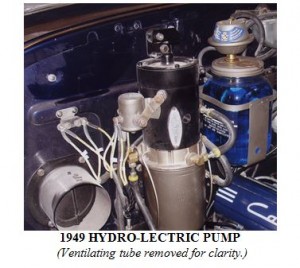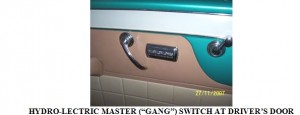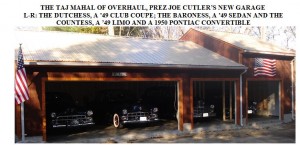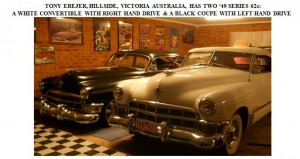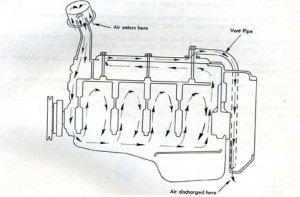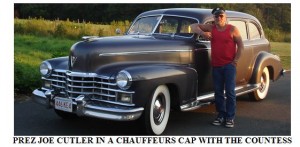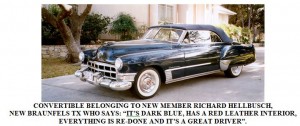If you’ve ever wondered how your hand brake works and particularly what makes the handle “spring” forward when you turn and release it, the following should tell you everything you need to know about this arcane subject.
There are three hand brake cables in the system. The first cable runs from the under-hood end of the familiar T-shaped chrome handle at the lower left of the dash to the top of the “hand brake relay lever”. This lever is the flat rod supported by a bolt in its middle which is located just inboard of the driver’s side inner fender. The second cable runs from the bottom of this relay lever, through a rubber-coated sheath under the car to the “equalizer”, which is a V-shaped metal piece in the center of the car, just to the rear of the X-member of the frame. The third cable runs to both rear wheels from the equalizer.
Near the rear end of the second cable, just before the cable itself emerges from the its rubber outer sheath, a metal part of the sheath, about 1½ inches long, is held to the frame by a clamp on the frame’s upper flange. (This clamp is just in front of the X-member of the frame.) Just to the rear of this clamped metal part of the sheath is an integral spring, through which passes the second emergency brake cable itself. Attached at the very rear end of this second cable is a several inch long screw or bolt whose threads go through the equalizer and upon which is screwed an adjusting nut which controls the third cable’s tension.
At each rear wheel, the third (rear) cable passes through the brake backing plate, then through an integral spring and finally to the “operating lever” on the rear brake shoe. (The integral spring is very stiff, which, as mentioned below, can make it difficult to remove the cable from the operating lever.) When you pull the T-shaped hand brake handle toward you, the operating lever presses against the “strut rod” between the two rear brake shoes and which in turn pushes the shoes against the brake drum. When you release the handle, the three springs mentioned (one at the second cable, two at the rear wheels) as well as the brake shoe springs themselves, cause the rear brake shoes to release and the T-shaped handle in your hand to move forward.
Tip: if you buy a second-hand strut rod, make sure that it is for a’49 as there is much variation in these between model years even though they are similar in appearance. For example, the ’48 rod is different from the ’49, while the ’49 left and right rods also fit 1950-52 Series 75 cars and all 1953-55 cars.
Speaking of emergency brake cables, when working on the rear (or secondary) brake shoe on the back wheel while doing a brake job have you ever struggled disconnecting and reconnecting the cable to the emergency brake operating lever? In my experience, the cable’s powerful spring sometimes fights back tooth and nail. So much so that the last time I did this it took me a long time to get both cables re-connected after lots of tries and choice words. Eventually, I had to loosen the emergency brake adjusting screw to make the job easier.
As a young guy I worked in a garage doing brake jobs and did this several times a day. In those days it was a breeze, so what happened in the intervening years? With age, either the springs got stiffer or my hands got weaker. So, if you’re an old guy like me, a better way to deal with the cable and spring is to leave it connected to the operating lever and, instead, detach the operating lever from the brake shoe at its upper end by unscrewing the bolt, nut and spring washer which hold it to the brake shoe. Then, after the brake shoe is re-lined, bolt the operating lever back on.
